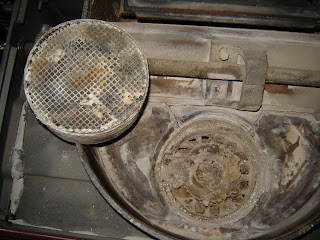This is the third catalytic I've put in this stove. We have a Dutchwest Large catalytic woodstove which we put in when we built the house in late 2003. We use it to provide most of our heating through the winter and burn about 4 to 5 cords of wood a year. At one time the Dutchwest stoves were one of cleanest burning woodstoves.
If you are unfamiliar with woodburning technology, a catalytic combustor "burns" the woodsmoke, making more heat from the fire and making the fire very clean burning with less smoke/particulate emissions. The catalytic lowers the combustion temperature from around 1000F down to 500F, letting the smoke "ignite" at a much lower temperature. Many new woodstove use "advanced combustion" technology which does not use a catalytic combustor, but these stoves are not as efficient/clean burning. The downside of catalytic combustors is you have to take care of them and they have a limited lifespan.
The first catalytic combustor lasted about 4 years. They say they should last up to five, so that isn't so bad. When I opened the stove up, the catalytic was badly cracked and crumbling. I've now learned that you need to be a bit "gentle" with your catalytic and not shock-cool it by adding "wet" wood to your fire by engaging the catalytic right away when refueling (the steam from the wood shock cools the catalytic, causing it to crack). I learned a lot about use, care and maintenance of the catalytic combustor in the woodstove since then. There is a really good guide called "Care and Replacement Manual for Woodstove Catalytic Combustors" that I found on Condor Corporation's (the folks that I got my new steel catalytic from) website.
The second catalytic only seemed to last a couple of years. Last year we had a lot less heating coming out of the stove. So, I ordered a new catalytic for this year. I got a so-called "Steel-cat" which is a steel catalytic converter instead of a ceramic one. It costs about $50 more, but is supposed to be more robust, ignites at about 400F instead of 500F (which is a lot lower!) and is supposed to be more efficient because there is more reaction surface due to the thinner walls of the catalytic honeycomb.
This picture shows my current catalytic as I pulled it out (honeycomb thing on the left). It looks like it was still in good shape, but lots of ash and debris on it. The air supply below looked pretty ashed/clogged up as well. Maybe it wasn't performing well because of clogging? The maintenance guides say you should open it up once a season and vacuum it out. I guess I should start doing that each year.
None the less, I have a new catalytic so I put it in. In this second picture you can see the new "steelcat" catalytic combustor on the right compared to the old ceramic one. Definitely much thinner walls and more open area, so hopefully that will make it burn better (more reaction area for the combustion to happen on, making more heat and less smoke).
So, how well does it work? Well, I made a small 2-log fire tonight to try it out. It seemed to light-off really easy with the combustor getting up to 800F with even the small fire. My old one seemed to struggle just to stay ignited (they "ignite" at around 500F).
And the heat seems to really be cranking out, which feels pretty nice. Maybe this means a few less logs for me to haul in this winter.
 |
| New steel catalytic combustor installed before re-assembling the woodstove top. |





No comments:
Post a Comment